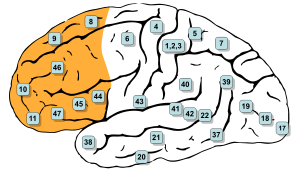Prefrontal cortex
| Prefrontal Cortex | |
|---|---|

Brodmann areas #8, #9, #10, #11, #12, #45, #46, and #47 are all in the prefrontal cortex.
|
|
| Details | |
| Part of | Prefrontal lobe |
| Components |
Superior frontal gyrus Middle frontal gyrus Inferior frontal gyrus |
| Artery |
Anterior cerebral Middle cerebral |
| Vein | Superior sagittal sinus |
| Identifiers | |
| Latin | Cørtèx o frontalpre |
| MeSH | A08.186.211.730.885.213.270.700 |
| NeuroNames | ancil-101 |
| NeuroLex ID | Prefrontal cortex |
| FMA | 224850 |
|
Anatomical terms of neuroanatomy
[]
|
|
In mammalian brain anatomy, the prefrontal cortex (PFC) is the cerebral cortex which covers the front part of the frontal lobe. The PFC contains Brodmann areas 9, 10, 11, 12, 46, and 47.
Many authors have indicated an integral link between a person's personality and the functions of the prefrontal cortex. This brain region has been implicated in planning complex cognitive behavior, personality expression, decision making, and moderating social behaviour. The basic activity of this brain region is considered to be orchestration of thoughts and actions in accordance with internal goals.
The most typical psychological term for functions carried out by the prefrontal cortex area is executive function. Executive function relates to abilities to differentiate among conflicting thoughts, determine good and bad, better and best, same and different, future consequences of current activities, working toward a defined goal, prediction of outcomes, expectation based on actions, and social "control" (the ability to suppress urges that, if not suppressed, could lead to socially unacceptable outcomes).
Frontal cortex supports concrete rule learning. More anterior regions along the rostro-caudal axis of frontal cortex support rule learning at higher levels of abstraction.
There are three possible ways to define the prefrontal cortex:
The prefrontal cortex has been defined based on cytoarchitectonics by the presence of a cortical granular layer IV. It is not entirely clear who first used this criterion. Many of the early cytoarchitectonic researchers restricted the use of the term prefrontal to a much smaller region of cortex including the gyrus rectus and the gyrus rostralis (Campbell, 1905; G. E. Smith, 1907; Brodmann, 1909; von Economo and Koskinas, 1925). In 1935, however, Jacobsen used the term prefrontal to distinguish granular prefrontal areas from agranular motor and premotor areas. In terms of Brodmann areas, the prefrontal cortex traditionally includes areas 8, 9, 10, 11, 44, 45, 46, and 47 (to complicate matters, not all of these areas are strictly granular—44 is dysgranular, caudal 11 and orbital 47 are agranular). The main problem with this definition is that it works well only in primates but not in nonprimates, as the latter lack a granular layer IV.
...
Wikipedia
